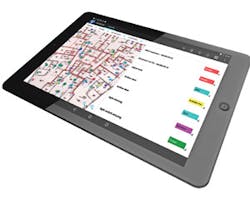Editor’s note: This article first appeared it the Sepetember 2016 issue of GX Contractor.
Building Information Modeling (BIM) is the culmination of a millennium of human efforts to graphically represent building projects. Architects have always required graphical representation of their buildings. This technology makes these designs come alive.
A Brief History of Architectural Drawings
Humanity’s first architectural drawing will be forever unknown to us because it was literally written on sand or traced in soft mud. The oldest-known site plan is on a granite slab discovered at a 14,000-year-old archeological site in Spain. It depicts the layout of a semi-permanent campsite established by neolithic hunter-gatherers, and shows the layout of its grass huts. It predates the oldest-known images of buildings by 6,000 years.
Ancient architects achieved levels of genius in their design of Egyptian pyramids, Greek temples, and Roman palaces. But not much is known of how they drew their architectural plans. A 3,500-year design of a garden on a painted wood tablet from ancient Egypt is the oldest-known-dimensioned architectural drawing. These designs must have existed, but were probably made on perishable sheets of papyrus or paper. (Existing Roman architectural designs are either set in mosaics or carved into marble.) There is evidence that the designs were drawn directly onto the building itself as it was being constructed with its floorplan laid out directly into the ground using posts and ropes.
What we would consider to be actual design plans would have to wait until the 13th century when architects and artists (usually the same person) grasped the concept of scale and perspective. By combining the beauty of renaissance artistic genius with detailed accuracy, the earliest-known architectural plans for medieval cathedrals were works of art, compared with modern functional designs. Very few of these design plans (or portfolios) survived since they were drawn on parchment. They were either lost or destroyed, or became palimpsests as the sheets were scraped clean and reused for new text and drawings.
At the business end of medieval design, the masons performing the actual work of turning the architects’ grand design into reality would perform detailed design work in “tracing houses.” Most of this design work was devoted to ornate detail drawings created and copied by the use of “prick holes.” These served two necessary functions.
First, they defined the geometric forms of the (circles, roses, arcs, fluted columns, and such). Combining them would create more detailed designs such as a cornice or apex of a window opening.
Second, some drawings were used as master designs that additional copies were made from by pricking through their holes into the sheets underneath. This process would transfer a précis (an essential summary of the design) onto a sheet of fresh parchment.
Combined with the floorplans locating the cathedral’s interior separating walls and rooms, exterior walls, and columns and buttresses for structural support, these designs allowed for the construction of some of the most majestic buildings in history—buildings that took the use of stone to its theoretical physical limits. And still, engineering analysis was rudimentary, but not completely lacking. These designers had a lifetime of practical know how and understanding of the basic strength characteristics of their building materials (stone, marble, brick, tile, and wood). However, structural failures both during construction and even decades after completion were not uncommon. As they said back then, cathedrals were built “by guess and by God.”
The modern era of architectural design began with the invention of blueprints. Invented in the 19th century, blueprints document a design by means of a contact print process on chemical treated sheets that are sensitive to light. The light-colored lines and blue background of the blueprints make any erasing or revisions obvious, thus preserving the integrity of the document. Since the 1940s, blueprints have been replaced by whiteprints (with the opposite color scheme of blue lines and white backgrounds).
One of the best examples of the time-consuming complexity of manual architectural drawings is one of the more recent major skyscraper designs to rely on old-fashioned hand drafting. Specifically, the design and construction of One Worldwide Plaza in mid-town Manhattan (as shown in the PBS documentary series Skyscraper ) in the late ’80s. Under scheduled pressure, excavation and foundation work had already begun before the architects had completed their design. Clients and tenant were buying building space before the architects had finalized their floorplans.
A fast-track project management method presented the designers with a series of design changes requested by the building’s owner. These were mostly aesthetic changes (like brickwork on the parapet) or detail work (like seams on the roof). In fact, the design and redesign process never really stopped throughout the entire construction effort, affecting everything from the joints in the facade’s stone work, to the look of the ash trays in the elevator lobbies.
The architect’s design ideas in turn presented severe challenges to the engineers, by replacing their original rectangular steel frame core idea with one that incorporated an elliptical open lobby space on the first floor. After months of redesign and engineering analysis, a solution was created that resembled the elliptical arcade designed by the architects without cutting into the main steel columns that supported the weight of the building. The architects and engineers performed these miracles of design and scheduling—on a project so large and complicated that it was literally too big for a human mind to fully grasp on its own—largely by hand, while coordinating the activities of more than 100 companies involved in all aspects of the project.
AutoCAD Applications
And then the computer emerged, revolutionizing the field of architecture and arriving just when it was most needed. The accelerated project schedule and increased complexity experienced by One Worldwide Plaza had become a universal problem for building projects large and small. It was during the late ’80s, when One Worldwide Plaza was being designed and built that computer assisted design (CAD) really came into the market.
Invented in the ’60s, the first CAD machines (like the first computes) were large and very expensive. Only a few were sold. By the ’70s, increased computing power and reduced cost moved CAD from a curiosity to an actual design tool with widespread applications. By the end of the decade, the first true commercial CAD companies were formed. The development of three-dimensional (3D) modeling and UNIX workstations in the ’80s made CAD commercially viable. What followed was steady growth with incremental improvements in functionality, speed, and ease of use. By the end of the decade, users were ditching in-house proprietary CAD systems for commercially available software. Advances in personal computers in the years since have allowed for the use of individual workstations, personal computers, and then even laptops.
A CAD system combines computer hardware, data management, and design software to allow for electronic graphical representation of engineering and architectural design drawings. Drawings are displayed on high-quality graphics monitors and are created with a mouse (or a light pen and digitizing tablet in older models). CAD programs come with pull down menus for drawing content and style along with operator viewing aids. Each line or other drawing element is stored in the software’s database and can be used as the basis for calculating quaintest (surface area, volumes, and such). This is all accomplished with improved speed and accuracy compared to traditional manual drawings.
3D Layout Systems provide precise location reference.
But for all of its improved efficiency and accuracy, CAD by itself is just another plan drawing. BIM was needed to take it to the next level where the plans become actual simulations of the construction and functioning of the project.
BIM Methods, Capabilities, and Applications
How does BIM differ from standard AutoCAD applications? Why is it so useful? Think of it as “design plus.” It integrates architectural, engineering, and construction work tasks by utilizing a digital building model that acts as the repository of data for the building’s systems. The goal is to enhance accuracy and efficiency by improving communication between multiple parties. The result is a virtual 3D
model of a building or other development that shows all aspects of its engineering, construction, operating systems (HVAC, electrical and lighting, escalators and elevators, and such), and material takeoffs showing quantities and types of construction materials.
Not only does it illustrate the building’s finished design, it can display its construction and subsequent functioning in real time. Model displays showing its construction can display not only how the project will look at each stage of its construction, but it also shows material needs as they are needed throughout construction. BIM is not so much a drawing as it is a holographic “movie.” As such, it gives an architect and the design team a “God’s view” of the entire project. And it is this ability to make 3D models that allows designers to better visualize their project.
Topcon’s LN-100 Layout Navigator is designed for BIM work.













